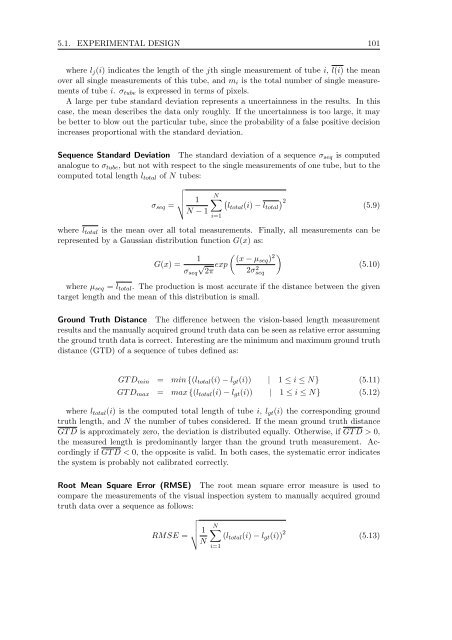Master Thesis - Fachbereich Informatik
Master Thesis - Fachbereich Informatik
Master Thesis - Fachbereich Informatik
You also want an ePaper? Increase the reach of your titles
YUMPU automatically turns print PDFs into web optimized ePapers that Google loves.
5.1. EXPERIMENTAL DESIGN 101<br />
where lj(i) indicates the length of the jth single measurement of tube i, l(i) themean<br />
over all single measurements of this tube, and mi is the total number of single measurements<br />
of tube i. σtube is expressed in terms of pixels.<br />
A large per tube standard deviation represents a uncertainness in the results. In this<br />
case, the mean describes the data only roughly. If the uncertainness is too large, it may<br />
be better to blow out the particular tube, since the probability of a false positive decision<br />
increases proportional with the standard deviation.<br />
Sequence Standard Deviation The standard deviation of a sequence σseq is computed<br />
analogue to σtube, but not with respect to the single measurements of one tube, but to the<br />
computed total length ltotal of N tubes:<br />
�<br />
�<br />
�<br />
σseq = � 1<br />
N − 1<br />
N�<br />
i=1<br />
� �2 ltotal(i) − ltotal<br />
(5.9)<br />
where ltotal is the mean over all total measurements. Finally, all measurements can be<br />
represented by a Gaussian distribution function G(x) as:<br />
G(x) =<br />
�<br />
1 (x − µseq)<br />
√ exp<br />
2π 2 �<br />
(5.10)<br />
σseq<br />
2σ2 seq<br />
where µseq = ltotal. The production is most accurate if the distance between the given<br />
target length and the mean of this distribution is small.<br />
Ground Truth Distance The difference between the vision-based length measurement<br />
results and the manually acquired ground truth data can be seen as relative error assuming<br />
the ground truth data is correct. Interesting are the minimum and maximum ground truth<br />
distance (GTD) of a sequence of tubes defined as:<br />
GT Dmin = min {(ltotal(i) − lgt(i)) | 1 ≤ i ≤ N} (5.11)<br />
GT Dmax = max {(ltotal(i) − lgt(i)) | 1 ≤ i ≤ N} (5.12)<br />
where ltotal(i) is the computed total length of tube i, lgt(i) the corresponding ground<br />
truth length, and N the number of tubes considered. If the mean ground truth distance<br />
GT D is approximately zero, the deviation is distributed equally. Otherwise, if GT D > 0,<br />
the measured length is predominantly larger than the ground truth measurement. Accordingly<br />
if GT D < 0, the opposite is valid. In both cases, the systematic error indicates<br />
the system is probably not calibrated correctly.<br />
Root Mean Square Error (RMSE) The root mean square error measure is used to<br />
compare the measurements of the visual inspection system to manually acquired ground<br />
truth data over a sequence as follows:<br />
�<br />
�<br />
�<br />
RMSE = � 1<br />
N�<br />
(ltotal(i) − lgt(i))<br />
N<br />
2<br />
(5.13)<br />
i=1














